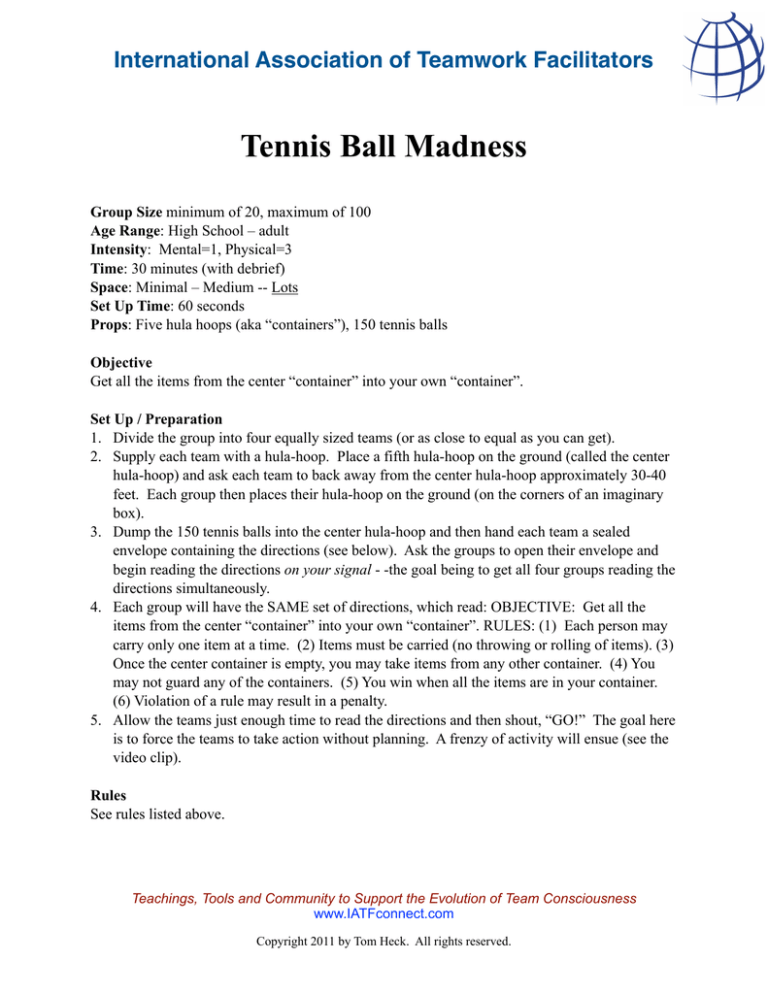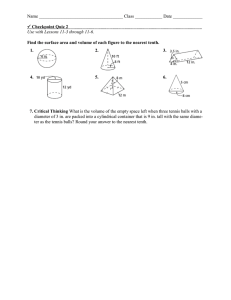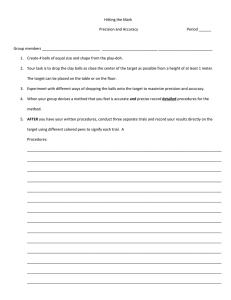
International Association of Teamwork Facilitators
Tennis Ball Madness
Group Size minimum of 20, maximum of 100
Age Range: High School – adult
Intensity: Mental=1, Physical=3
Time: 30 minutes (with debrief)
Space: Minimal – Medium -- Lots
Set Up Time: 60 seconds
Props: Five hula hoops (aka “containers”), 150 tennis balls
Objective
Get all the items from the center “container” into your own “container”.
Set Up / Preparation
1. Divide the group into four equally sized teams (or as close to equal as you can get).
2. Supply each team with a hula-hoop. Place a fifth hula-hoop on the ground (called the center
hula-hoop) and ask each team to back away from the center hula-hoop approximately 30-40
feet. Each group then places their hula-hoop on the ground (on the corners of an imaginary
box).
3. Dump the 150 tennis balls into the center hula-hoop and then hand each team a sealed
envelope containing the directions (see below). Ask the groups to open their envelope and
begin reading the directions on your signal - -the goal being to get all four groups reading the
directions simultaneously.
4. Each group will have the SAME set of directions, which read: OBJECTIVE: Get all the
items from the center “container” into your own “container”. RULES: (1) Each person may
carry only one item at a time. (2) Items must be carried (no throwing or rolling of items). (3)
Once the center container is empty, you may take items from any other container. (4) You
may not guard any of the containers. (5) You win when all the items are in your container.
(6) Violation of a rule may result in a penalty.
5. Allow the teams just enough time to read the directions and then shout, “GO!” The goal here
is to force the teams to take action without planning. A frenzy of activity will ensue (see the
video clip).
Rules
See rules listed above.
Teachings, Tools and Community to Support the Evolution of Team Consciousness
www.IATFconnect.com
Copyright 2011 by Tom Heck. All rights reserved.
International Association of Teamwork Facilitators
Safety Warning
Make sure the area you intend to run this activity in is free and clear of holes or things the
participants could slip on.
Comments
1. When you yell “GO!” the groups will have just enough information to begin taking action. If
you wait too long and allow the groups to read through the information AND start to make a
plan, they may decide to work cooperatively right off the bat (without going through all the
frenzy).
2. When you yell “Go!” without allowing them to plan, they will usually run to the center hoop
and start grabbing tennis balls. The center hoop will quickly empty (within 60 – 90 seconds)
and then the groups will begin taking balls from the neighboring hoops. Usually within 3 or
4 minutes most will start to catch on that it’s nearly impossible to ever win unless something
changes. What needs to change? The way the group thinks. They must begin to think of a
solution where everyone can win.
3. Most groups decide to cooperate by stacking ALL of the hula-hoops and then placing all of
the balls inside the stack of hula-hoops. This is “legal” according to the rules.
4. This activity can work even better (i.e. people become more competitive) by getting the small
work groups to do something competitive prior to the Tennis Ball Madness activity. Any old
competitive activity will do. The point is to get them working in small teams and thinking
competitively just before the Tennis Ball Madness activity. I’m trying to “set the group up”.
This way, they are more likely to work really hard during Tennis Ball Madness which usually
equates to everyone learning the lessons at a deeper (more emotional) level.
Debriefing Suggestions
1. The way I usually debrief this activity is to ask the groups to form into groups of 7 – 10
people making sure someone from each of the previous work groups is represented in this
new discussion group. I then ask them to discuss the following (I show this to them on a
piece of paper: Lose – Lose, Win – Lose, Win – Win. That’s usually all it takes for the small
discussion groups to have a good conversation. I give the small groups 5 or 10 minutes to
discuss ideas and then we meet back as a large group to share insights.
2. TRUE STORY: I led this activity with the teaching staff of a public middle school. Just like
every other group that plays this game, everyone ran around trying to win the game by
placing all the balls in their own hoop. Then, as the group got tired of running, a teacher
suggested letting one team win by placing all the balls in their hoop. The other three teams
conceded defeat and everyone placed the balls in the fourth team’s hoop. During the debrief,
we discussed win-lose (which is what they decided on), lose-lose, and win-win. One of the
teachers suggested that their solution (a win-lose solution) was more realistic. She argued
that the “real world” doesn’t play by win-win and they shouldn’t teach that type of thinking
Teachings, Tools and Community to Support the Evolution of Team Consciousness
www.IATFconnect.com
Copyright 2011 by Tom Heck. All rights reserved.
International Association of Teamwork Facilitators
to the kids. In the real world she said, people are out to get you and you better watch out for
yourself. No one in the room challenged this teacher. Even the principal was in agreement.
Imagine having these teachers work with YOUR child! This team, by the way, was
experiencing a number of very deep and difficult challenges. After some dialogue, I was able
to help the teachers see that win-win thinking is valuable and alive in our everyday society.
Common insights:
1. Lose-Lose and Win-Lose require lots more energy.
2. We must be on the look out for Win-Win opportunities from the outset.
3. One person can make all the difference in the world. NOTE – This will usually be an insight
when one person is responsible for getting the group to stop the frenzy and come up with a
Win-Win answer (i.e. stack the hula-hoops). All it takes is one committed person to see
things differently AND have the courage and conviction to make their views known to the
larger community.
4. Sometimes I’ll ask the small discussion groups to identify what the tennis balls and the hulahoops are metaphorically.
Variations
1. If the group size is small (20 people), have one central hoop (aka “container”) and only three
outer hoops - - i.e. divide the group of 20 into only three working teams instead of four.
Keeping the work teams at a minimum size of seven people seems to work better than
allowing them to get too small (smaller than 7).
2. No tennis balls? Try cutting up foam noodles into 2-inch sections. You can find foam
noodles at department stores that sell pool toys. They cut really easily with a bread knife.
Don’t want to deal with foam noodles? Go to the craft store and buy a bag full of soft fuzzy
balls that are about an inch in diameter. These are supper easy to carry on a plane.
3. No hula-hoops? Not to worry. Create some hula-hoop size rings out of short sections of rope
or string.
History
I first learned this activity from Sam Skies who has authored many great book on team building
activities including “Executive Marbles” and “Feeding the Zircon Gorilla”.
Teachings, Tools and Community to Support the Evolution of Team Consciousness
www.IATFconnect.com
Copyright 2011 by Tom Heck. All rights reserved.




